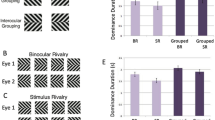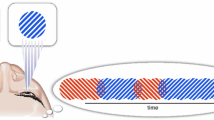Abstract
A midbrain neural basis for the perceptualoscillations of binocular rivalry is suggestedon the basis of fMRI studies of rivalry andinferences from the properties of rivalry thatcannot be explained from the known propertiesof primary visual cortical (V1) neurons. Therivalry switch is proposed to activatehomologous areas of each cerebral hemispherealternately, by means of a bistable oscillatorcircuit that straddles the midline of theventral tegmentum. This bistable oscillatoroperates at the same slow rate that ischaracteristic of perceptual rivalryalternations. Whilst attempting to divert thepresent preoccupation with cortical mechanismsfor rivalry, the new proposal integrates manycortical areas, in keeping with recent evidencethat binocular rivalry involves widespreadareas of the hemispheres. By linking rivalry tointerhemispheric switching mechanisms in thisway, the new proposal for the switch makes theprediction that binocular rivalry will besubject to high level influences such as moodand motivation. These predictions are beingfulfilled, with rivalry playing an increasingrole in the diagnosis and understanding if mooddisorders, schizophrenia and other psychiatricconditions.
Similar content being viewed by others
References
Atkinson, J.,Campbell, F.W.,Fiorentini, A. andMaffei, L., 1973: The dependence of monocular rivalry on spatial frequency, Perception 2, 127-133.
Andrews, T.J. andPurves, D., 1997: Similarities in normal and binocularly rivalrous viewing, Proc. Natl. Acad. Sci. USA 94, 9905-9908.
Bair, W.,Zohary, E. andNewsome, W.T., 2001: Correlated firing in macaque visual area MT: Time scales and relationship to behavior, J. Neurosci. 21, 1676-1697.
Baloh, R.W.,Honrubia, V. andKonrad, H.R., 1976: Periodic alternating nystagmus, Brain 99: 11-26.
Bejjani, B.-P.,Damier, P.,Arnulf, I.,Thivard, L.,Bonnet, A.-M. andDormont, D., 1999: Transient acute depression induced by high-frequency deep-brain stimulation, New Engl. J. Med. 340, 1476-1480.
Blake, R., 1989: A neural theory of binocular rivalry, Psychol. Rev. 96, 145-167.
Blake, R.,Westendorf, D.H. andYang, Y., 1991: Discriminating binocular fusion from false Fusion, Invest. Ophthalmol. Vis. Sci. 32, 2821-2825.
Blakemore, C., 1969: Binocular depth discrimination and the nasotemporal division, J. Physiol. 205, 471-497.
Blasdel, G.,Mitchell, D.E.,Muir, D.W. andPettigrew, J.D., 1977: A physiological and behavioural study in cats of the effect of early visual experience with contours of a single orientation, J. Physiol. 265, 615-636.
Bonneh, Y. andSagi, D., 1999: Configuration saliency revealed in short duration binocular rivalry, Vision Res. 39, 271-281.
Bottini, G.,Sterzi, R.,Paulesu, E.,Vallar, G.,Cappa, S. F. andErminio, F., 1994: Identification of the central vestibular projections in man: a positron emission tomography activation study, Exp. Brain Res. 99, 164-169.
Breese, B.B., 1899: On inhibition, Physiol. Monogr. 3, 1-65.
Campbell, F.W.,Gilinsky, A.S.,Howell, E.R.,Riggs, L.A. andAtkinson, J., 1973: The dependence of monocular rivalry on orientation, Perception 2: 123-125.
Carlson, T.A. andHe, S., 2000: Visible binocular beats from invisible monocular stimuli during binocular rivalry, Curr Biol. 10, 1055-1058.
Cohen, S.M.,Xu, J.D.,Radkov, E., et al., 2000: Syntheses and relaxation properties of mixed gadolinium hydroxypyridinonate MRI contrast agents, Inorg. Chem 39, 5747-5756.
Crick, F. andKoch, C., 1995: Are we aware of neural activity in primary visual cortex? Nature 375, 121-123.
Damasio, A., 2000: The Feeling of What Happens. Harcourt, NY.
Diaz-Caneja, E, 1928: Sur líalternance binoculaire, Annales D'Oculistique 165, 721-731.
Engel, A.K.,Roelfsema, P.R.,Fries, P.,Brecht, M. andSinger, W., 1997: Role of the temporal domain for response selection and perceptual binding, Cereb Cortex 7, 571-582.
Gross, C.G.,Rodman, H.R.,Gochin, P.M. andColombo, M.W., 1993: Inferior temporal cortex as a pattern recognition device, in E. Baum (ed.), Computational Learning and Cognition: Proceedings of the 3rd NEC Research Symposium.
Harrad, R.A.,McKee, S.P.,Blake, R. andYang, Y., 1994: Binocular rivalry disrupts stereopsis, Perception 23, 15-28.
Hart, N.S.,Partridge, J.C. andCuthill, I.C., 2000: Retinal asymmetry in birds, Curr. Biol. 10, 115-117.
Howard, I.P., 1995: Depth from binocular rivalry without spatial disparity, Perception 24, 67-74.
Humphrey, G. Keith andGoodale, Melvyn A., 1998: Probing unconscious visual processing with the McCollough effect, Consciousness and Cognition 7, 494-519.
Hunt, J. andGuilford, J.P., 1933: Fluctuation of an ambiguous figure in dementia praecox and in manic-depressive patients, J. Abnorm. Soc. Psychol. 27, 443-452.
Kovacs, I.,Papathomas, T.V.,Yang, M. andFeher, A, 1996: When the brain changes its mind: Interocular grouping during binocular Rivalry, Proc. Natl. Acad. Sci. USA 93, 15508-15511.
Lai, Y.Y. andSiegel, J.M., 1988: Medullary regions mediating atonia, J. Neurosci 8, 4790-4796.
Laing, C.R. andChow, C.C., 2001: A spiking neuron model of binocular rivalry, J. Comput. Neurosci. (submitted).
Lee, S.H. andBlake, R., 1999: Rival ideas about binocular rivalry, Vision Res. 39, 1447-1454.
Leopold, D.A. andLogothetis, N.K., 1996: Activity changes in early visual cortex reflect monkey's percepts during binocular rivalry, Nature 379, 549-553.
Leopold, D.A. andLogothetis, N.K., 1999: Multistable phenomena: changing views in perception, Trends in Cognitive Sciences 3, 254-264.
Liu, L.,Tyler, C.W. andSchor, C.M., 1992: Failure of rivalry at low contrast: evidence of a suprathreshold binocular summation process, Vision Res. 32, 1471-1479.
Livingston, M., 2001: A spatial frequency interpretation of Mona Lisa, Science.
Logothetis, N.K., 1998: Single units and conscious vision, Phil. Trans. R. Soc. Lond. B 353, 1801-1818.
Logothetis, N.K.,Leopold, D.A. andSheinberg, D.L., 1996: What is rivaling during binocular rivalry? Nature 380, 621-624.
Lotto, R.B.,Williams, S.M. andPurves, D., 1999: An empirical basis for Mach bands, Proc Natl. Acad. Sci. U.S.A. 96, 5239-5244.
Luck, S.J.,Hillyard, S.A.,Mangun, G.R. andGazzaniga, M.S., 1989: Independent hemispheric attentional systems mediate visual search in split-brain patients, Nature 342, 543-545.
Lumer, E.D.,Friston, K.J. andRees, G., 1998: Neural correlates of perceptual rivalry in the human brain, Science 280, 1930-1934.
Mackay, D.M. andMackay, V., 1982: Explicit dialogue between left and right half systems of split brains, Nature 295, 690.
Marder, E. andCalabrese, R.L., 1996: Principles of rhythmic motor pattern generation, Physiol. Rev. 76, 687-717.
Miller, S.M.,Liu, G.B.,Ngo, T.T.,Hooper, G.,Riek, S.,Carson, R.G. andPettigrew, J.D., 2000: Interhemispheric switching mediates perceptual rivalry, Curr. Biol. 10, 383-392.
Miller, S.M.,Mitchell, P.B.,Ngo, T.,Gynther, BM,Hyslop, K.,Petigrew J.D. andGeffen L., 2001 (submitted): Slow binocular rivalry in bipolar disorder.
Munk, M.H.J.,Roelfsema, P.R.,Konig, P.,Engel, A.K. andSinger, W., 1996: Role of reticular activation in the modulation of intracortical synchronization, Science 272, 271-274.
Ngo, T.T.,Miller, S.M.,Liu, G.B. andPettigrew, J.D., 2000: Binocular rivalry and perceptual coherence. Curr. Biol. 10, R134-136.
Parfionovitch, Y.,Meyer, F. andDorje, G., 1992: Tibetan Medical Paintings, Illustrations by Sangye Gyamtso. Serindia Pub. Harry N. Abrams Inc., New York.
Pettigrew, J.D. andMiller, S.M., 1998: A “sticky” interhemispheric switch in bipolar disorder? Proc. R. Soc. Lond. B 265, 2141-2148.
Pettigrew, J.D.,Collin, S.P. andOtt, M., 1999: Convergence of highly-specialized behavior, eye movements and visual optics in the sandlance (Teleostei) and the chameleon (Reptilia), Curr Biol 9, 421-424.
Phillipson, O.T., 1979: Afferent projections to the ventral tegmental area of Tsai and interfascicular nucleus: a horseradish peroxidase study in the rat, J. Comp. Neurol. 187, 117-143.
Poeppel, E.,Brinkmann, R.,von Cranow, D. andSinger, W., 1978: Association and dissociation of visual functions in a case of bilateral occipital lobe infarction, Arch. Psyciat. Nervenk. 225, 1-21.
Polonsky, A.,Blake, R.,Braun, J. andHeeger, D.J., 2000: Neuronal activity in human primary visual cortex correlates with perception during binocular rivalry, Nat. Neurosci. 3, 1153-1159.
Purves, D.,Shimpi, A. andLotto, R.B., 1999: An empirical explanation of the Cornsweet effect, J. Neurosci. 19, 8542-8551.
Ramachandran, V.S., 1994: Phantom limbs, neglect dyndromes, repressed memories, and Freudian psychology, Int. Rev. Neurobiol., 37, 291-333.
Ramachandran, V.S.,Cobb, S. andLevi, L., 1994: The neural locus of binocular rivalry and monocular diplopia in intermittent exotropes, Neuroreport May 9; 5(9), 1141-1144.
Rowat, P.F. andSelverston, A.I., 1997: Oscillatory mechanisms in pairs of neurons connected with fast inhibitory synapses, J. Comp. Neurosci. 4, 103-127.
Russell, B., 1935: Religion and Science. The Home University of Modern Knowledge. Thornton Butterworth Ltd, London.
Searle, J.R., 2000: Consciousness, Annu Rev Neurosci. 23, 557-578.
Sengpiel, F., 2000: Binocular rivalry: Ambiguities resolved, Curr. Biol. 7, R447-R450.
Sengpiel, F.,Blakemore, C. andHarrad, R., 1995: Interocular suppression in the primary visual cortex: a possible neural basis of binocular rivalry, Vision Res. 35, 179-195.
Shannahoff-Khalsa, D, 1993: The Ultradian rhythm of alternating cerebral hemispheric activity, Int. J. Neurosci. 70, 285-298.
Sheinberg, D.L. andLogothetis, N.K., 1997: The role of temporal cortical areas in perceptual organization, Proc. Natl. Acad. Sci. U.S.A. 94, 3408-3413.
Srinivasan, R.,Russel, D.P.,Edelman, G.M. andTononi, G., 1999: Increased synchronization of neuromagnetic responses during conscious perception, J. Neurosci. 19, 5435-5448.
Stone, J., 1966: The nasotemporal division of the cat's retina, J. Comp. Neurol. 126, 585-600.
Stone, J.,Leicester, J. andSherman, S.M., 1973: The nasotemporal division of the monkey's retina, J. Comp. Neurol. 150, 333-348.
Suthers, R.A., 1997: Peripheral control and lateralization of birdsong, J. Neurobiol. 33, 632-652.
Tong, F.,Nakayama, K.,Vaughan, J.T. andKanwisher, N., 1998: Binocular rivalry and visual awareness in human extrastriate cortex, Neuron. 21, 753-759.
Vallar, G.,Bottini, G.,Rusconi, M.L. andSterzi, R., 1993: Exploring somatosensory hemineglect by vestibular stimulation, Brain 116, 71-86.
Vitte, E.,Derosier, C.,Caritu, Y.,Berthoz, A.,Hasboun, D. andSoulie, D., 1996: Activation of the hippocampal formation by vestibular stimulation: a functional magnetic resonance imaging study, Exp. Brain Res. 112, 523-526.
Wade, N.J., 1998: Early studies of eye dominances, Laterality 3, 97-108.
Wade, N.J. andWenderoth, P., 1978: The influence of color and contour rivalry on the magnitude of the tilt after-effect, Vision Res. 18, 827-836.
van der Zwan, R. andWenderoth, P., 1994: Psychophysical evidence for area V2 involvement in the reduction of subjective contour tilt aftereffects by binocular rivalry, Vis Neurosci. 11, 823-830.
Vidyasagar, T.R., 1998: Gating of neuronal responses in macaque primary visual cortex by an attentional spotlight, Neuroreport 9, 1947-1952.
Walker, P., 1975: Stochastic properties of binocular rivalry alternations, Percept Psychophys 18, 467-473.
Wolfe, J.M.,Alvarez, G.A. andHorowitz, T.S., 2000: Attention is fast but volition is slow, Nature 406, 691.
Zaidel, E.,Clarke, J.M. andSuyenobu, B., 1990: Hemispheric independence: a paradigm case for cognitive neuroscience, in A.B. Scheibel andA. Wechsler (eds), A Neurobiology of Higher Cognitive Function, The Guilford Press, New York, pp. 297-355.
Author information
Authors and Affiliations
Rights and permissions
About this article
Cite this article
Pettigrew, J.D. Searching for the Switch: Neural Bases for Perceptual Rivalry Alternations. Brain and Mind 2, 85–118 (2001). https://doi.org/10.1023/A:1017929617197
Issue Date:
DOI: https://doi.org/10.1023/A:1017929617197




